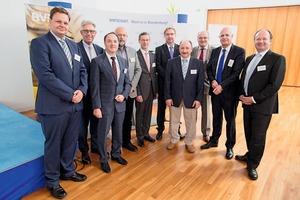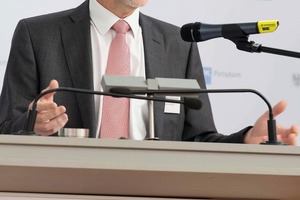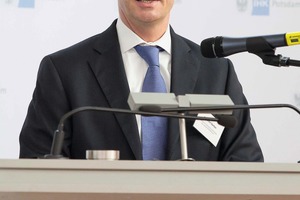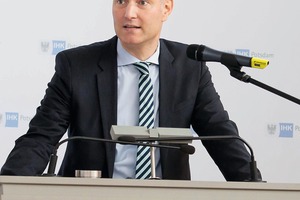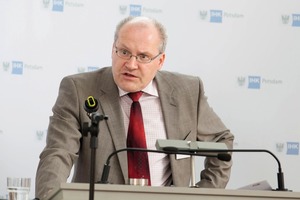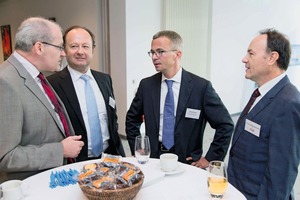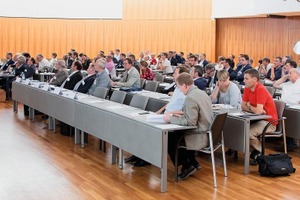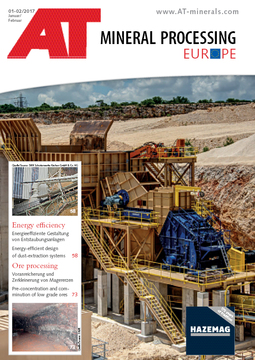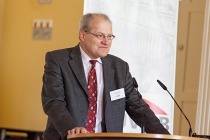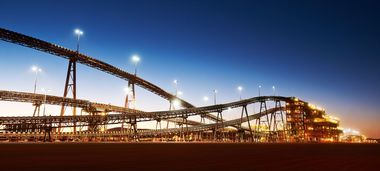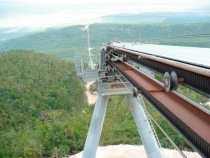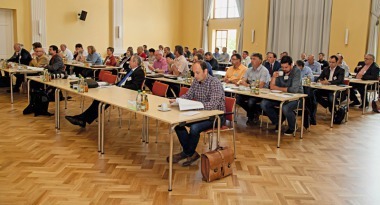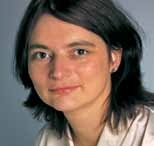Brandenburg Raw Material Day 2016 in Potsdam
After more than 15 years, Brandenburg continued the tradition of its Raw Material Day in 2016, which met with great interest. More than 150 participants from economy, administration and politics accepted the invitation and took part in the Raw Material Day at the Potsdam Chamber of Industry and Commerce on 14 September 2016. The event offered a wide range of topics dealing with the utilization of domestic raw materials, power generation, raw material securing, biodiversity and the social acceptance of the raw material economy. The event was jointly organized by the Ministry of Economy and Energy of the federal state of Brandenburg, the Regional Office for Mining, Geology and Raw Materials (LBGR), the Employers’ Association of Mineral Building Materials (UVMB) as well as the Chambers of Industry and Commerce (IHK) of the federal state of Brandenburg.
The program of lectures particularly dealt with the utilization of lignite and its economic importance for Lusatia as well as with the trends of development towards a long-term demand for raw material for the building industry. At the same time, the continuously increasing requirements of the environmental legislation, to which the mining and raw material industries must adapt themselves in the long run, were made a subject of discussion.
Thomas Weber from Cemex Zement GmbH impressively explained that it is quite possible to combine raw material extraction and the protection of species demonstrated by the example of the limestone quarry at Rüdersdorf. He proved that there the extraction of limestone and the protection of bats are not contradictory. Dr. Jens Nissen from the Beeskow-based Bayerngas GmbH reported on the long process to the acceptance and the handling of the justified demands of a citizens’ initiative as planned drilling for natural gas extraction was approaching.
“Brandenburg is a treasury of mineral raw materials. For more than 800 years at Rüdersdorf they have been extracting limestone, which you can found in many buildings in Berlin”, said Albrecht Gerber, Minister of Economy and Energy, in his words of welcome. More than 20 million tons of rock and associated products are extracted in Brandenburg every year. Additionally they extract natural gas, petroleum and, in particular, more than 30 million tons of lignite per year. After the Swedish Energy Group Vattenfall sold the lignite of Lusatia to the Czech EPH Group, they certainly “have found a reliable partner, but only with stable general conditions of the energy policy”, Gerber appealed to the federal politics. Only with a reasonable energy policy, a network expansion and new storage technologies, the planned “Decarbonisation of Germany by 2050” will be possible.
“Knowledge is the raw material of the future” - Prof. Dr. Mario Tobias, general manager of the Potsdam Chamber of Industry and Commerce and host of the Raw Material Day, transferred this motto to the raw material economy in his welcoming speech: “… t is important to know how we will efficiently handle our raw materials in the future”. This especially refers to lignite, but also to gravel and sand, “which has enabled the building boom in Berlin”.
Bert Vulpius, the managing director of the UVMB, took up this statement and critically investigated the topic of the securing of raw material deposits within the framework of the state and regional planning in Brandenburg. For example, the demands of the federal lawmaker laid down in the regional policy law of 2008 have not become part of the regional planning so far. “We have long critized this. Since 2008 three new regional plans have been prepared without taking into account this topic. Precautionary raw material securing is particularly important because the “time required for the exploration of mineral raw materials” has essentially been reduced during the last 25 years. During this period about 550 million tons of building raw materials have been supplied to the market as building products from deposits in Brandenburg. For this reason, the storage basis must be strengthened and the raw material potentials have to be secured as a precaution in the long term. “Regional planning prerequisites have to be created as a precautionary securing measure and for the extraction of local domestic raw materials. For this purpose, priority zones for the extraction of raw materials and for the long-term securing of raw material deposits have to be laid down”, is the demand of the UVBM according to Vulpius. The Central German states show in an exemplary manner in the Land Development Programs how this can be done.
“The nature conservation organisations have learned something new and now have a new focus”, Prof. Dr. Bernd Dammert from the Leipzig-based office Rechtsanwälte Dr. Dammert & Steinforth warned against unpleasant surprises. After a few defeats, the environmental non-governmental organisations have found out that, it is either impossible or only hardly possible to hinder raw material extraction by means of the mining law. Above all, now they are concentrating on the environmental legislation. “These associations are well organised and have sufficient financial resources and must not be underrated”, according to Dammert. In this case companies are well-advised, which can prove well-founded that there is “a public interest in raw material extraction” during the corresponding consideration proceedings. “During this process the importance of the raw material associations is increased, which are observing the development and, consequently, are able to bundle up the interests of the companies”, said Dammert.
After the lecture by Uwe Grosser, Board Member ‘Mining’ of the joint executive board of Vattenfall Europe Mining AG and Vattenfall Europe Generation AG, questions arose in the interested expert audience as to whether the “Decarbonisation of Germany by 2050” could be a realistic and an economically desirable aim. With its lignite Germany has a favourable domestic energy source, which will be available for a long time and which will ensure the supply of the connected power stations around the clock. Furthermore, it ensures jobs, training and value creation in Lusatia, continued Grosser.
After the planned end of the lignite extraction in the quarry Cottbus-Nord, he described the future development of the lignite district of Lusatia with the remaining four large quarries and the four power plant locations. The flooding of the quarry area Cottbus-Nord will be started in the years 2018/2019. After about six years of flooding, here the largest artificial lake in Germany with a water area of 19 km² will be created. Its name will be Cottbusser Ostsee. The participants listened with special interest to Grossers’s explanation regarding the new owner of the lignite quarries and power plants of Lusatia.
Thomas Schroschk, Head of the Department “Rock and associated products as well as energy” of the LBGR, underlined the economic importance of his office in his lecture. In addition to the classic mining of lignite as well as of the raw materials of rock and associated products, further main topics are the borehole mining for the extraction of petroleum and natural gas, the underground storage and the utilization of geothermal potentials, the redevelopment mining and the regeneration of old mines, the planning of energy routes as well as the use of mineral waste. The department “Geology” of the LBGR also carries out tasks of the Regional Geological Service. The raw material, engineering and hydrogeology carry out important preliminary work for the use of the geopotentials of Brandenburg. The possible utilization of the copper shale of Lusatia is an economically interesting project for the future of the state, said the departmental head Schroschk.
In his closing speech Bert Vulpius, the Managing Director of the UVMB, expressed his thanks to all lecturers and organizers of the Raw Material Day. With his words “certainly 15 years will not pass by”, he held out the prospect of a new edition of the Brandenburg Raw Material Day.

